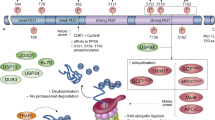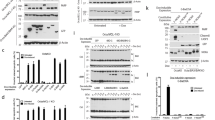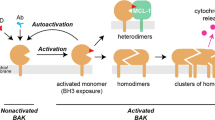Abstract
Pro- and antiapoptotic proteins of the large Bcl-2 family are critical regulators of apoptosis via the mitochondrial pathway. Whereas antiapoptotic proteins of the family share all four Bcl-2 homology domains (BH1–BH4), proapoptotic members may lack some of these domains, but all so far described proapoptotic Bcl-2 proteins enclose BH3. The bcl-x gene gives rise to several alternative splice products resulting in proteins with distinct functions as the antiapoptotic Bcl-xL and proapoptotic Bcl-xS. Here, we describe a novel Bcl-x splice product of 138 amino acids termed Bcl-xAK (Atypical Killer), which encloses the Bcl-2 homology domains BH2 and BH4 as well as the transmembrane domain, but lacks BH1 and BH3. Weak endogenous expression of Bcl-xAK was seen in melanoma and other tumor cells. Interestingly, its overexpression by applying a tetracycline-inducible expression system resulted in significant induction of apoptosis in melanoma cells, which occurred in synergism with drug-induced apoptosis. After exogenous overexpression, Bcl-xAK was localized both in mitochondrial and in cytosolic cell fractions. By these findings, a completely new class of Bcl-2-related proteins is introduced, which promotes apoptosis independently from the BH3 domain and implies additional, new mechanisms for apoptosis regulation in melanoma cells.
This is a preview of subscription content, access via your institution
Access options
Subscribe to this journal
Receive 50 print issues and online access
$259.00 per year
only $5.18 per issue
Buy this article
- Purchase on Springer Link
- Instant access to full article PDF
Prices may be subject to local taxes which are calculated during checkout






Similar content being viewed by others
Abbreviations
- NHM:
-
normal human melanocytes
- RT–PCR:
-
reverse transcriptase–polymerase chain reaction
- LDH:
-
lactate dehydrogenase
- BH domain:
-
Bcl-2 homology domain
References
Ban J, Eckhart L, Weninger W, Mildner M, Tschachler E . (1998). Biochem Biophys Res Commun 248: 147–152.
Bargou RC, Daniel PT, Mapara MY, Bommert K, Wagener C, Kallinich B et al. (1995). Int J Cancer 60: 854–859.
Bean MA, Bloom BR, Herberman RB, Old LJ, Oettgen HF, Klein G et al. (1975). Cancer Res 35: 2902–2913.
Boise LH, Gonzalez-Garcia M, Postema CE, Ding L, Lindsten T, Turka LA et al. (1993). Cell 74: 597–608.
Borner C . (2003). Mol Immunol 39: 615–647.
Bours V, Bentires-Alj M, Hellin AC, Viatour P, Robe P, Delhalle S et al. (2000). Biochem Pharmacol 60: 1085–1089.
Bruggen J, Fogh J, Sorg C . (1981). J Cancer Res Clin Oncol 102: 141–152.
Cardone MH, Salvesen GS, Widmann C, Johnson G, Frisch SM . (1997). Cell 90: 315–323.
Carey TE, Takahashi T, Resnick LA, Oettgen HF, Old LJ . (1976). Proc Natl Acad Sci USA 73: 3278–3282.
Clarke MF, Apel IJ, Benedict MA, Eipers PG, Sumantran V, Gonzalez-Garcia M et al. (1995). Proc Natl Acad Sci USA 92: 11024–11028.
Daniel PT, Schulze-Osthoff K, Belka C, Guner D . (2003). Essays Biochem 39: 73–88.
del Peso L, Gonzalez-Garcia M, Page C, Herrera R, Nunez G . (1997). Science 278: 687–689.
Diaz JL, Oltersdorf T, Horne W, McConnell M, Wilson G, Weeks S et al. (1997). J Biol Chem 272: 11350–11355.
Eberle J, Fecker LF, Bittner JU, Orfanos CE, Geilen CC . (2002). Br J Cancer 86: 1957–1962.
Eberle J, Fecker LF, Hossini AM, Wieder T, Daniel PT, Orfanos CE et al. (2003). Oncogene 22: 9131–9141.
Eberle J, Weitmann S, Thieck O, Pech H, Paul M, Orfanos CE . (1999). J Invest Dermatol 112: 925–932.
Eskes R, Desagher S, Antonsson B, Martinou JC . (2000). Mol Cell Biol 20: 929–935.
Fecker LF, Eberle J, Orfanos CE, Geilen CC . (2002). J Invest Dermatol 118: 1019–1025.
Fults D, Pedone CA, Morse HG, Rose JW, McKay RD . (1992). J Neuropathol Exp Neurol 51: 272–280.
Giard DJ, Aaronson SA, Todaro GJ, Arnstein P, Kersey JH, Dosik H et al. (1973). J Natl Cancer Inst 51: 1417–1423.
Gillissen B, Essmann F, Graupner V, Starck L, Radetzki S, Dorken B et al. (2003). EMBO J 22: 3580–3590.
Gossen M, Bujard H . (1992). Proc Natl Acad Sci USA 89: 5547–5551.
Grad JM, Zeng XR, Boise LH . (2000). Curr Opin Oncol 12: 543–549.
Grillot DA, Gonzalez-Garcia M, Ekhterae D, Duan L, Inohara N, Ohta S et al. (1997). J Immunol 158: 4750–4757.
Gross A, McDonnell JM, Korsmeyer SJ . (1999). Genes Dev 13: 1899–1911.
Guo B, Godzik A, Reed JC . (2001). J Biol Chem 276: 2780–2785.
Hipp ML, Bauer G . (1997). Oncogene 15: 791–797.
Holzmann B, Lehmann JM, Ziegler-Heitbrock HW, Funke I, Riethmuller G, Johnson JP . (1988). Int J Cancer 41: 542–547.
Hossini AM, Eberle J, Fecker LF, Orfanos CE, Geilen CC . (2003a). FEBS Lett 553: 250–256.
Hossini AM, Eberle J, Fecker LF, Orfanos CE, Geilen CC . (2003b). Arch Dermatol Res 294: 499, abstract 153.
Hussein MR, Haemel AK, Wood GS . (2003). J Pathol 199: 275–288.
Jin KL, Graham SH, Mao XO, He X, Nagayama T, Simon RP et al. (2001). J Neurochem 77: 1508–1519.
Johnstone RW, Ruefli AA, Lowe SW . (2002). Cell 108: 153–164.
Kelekar A, Thompson CB . (1998). Trends Cell Biol 8: 324–330.
Kim MR, Lee JY, Park MT, Chun YJ, Jang YJ, Kang CM et al. (2001). FEBS Lett 505: 179–184.
Leech SH, Olie RA, Gautschi O, Simoes-Wust AP, Tschopp S, Haner R et al. (2000). Int J Cancer 86: 570–576.
Li H, Yuan J . (1999). Curr Opin Cell Biol 11: 261–266.
Liao SK, Dent PB, McCulloch PB . (1975). J Natl Cancer Inst 54: 1037–1044.
Lindenboim L, Yuan J, Stein R . (2000). Oncogene 19: 1783–1793.
Losonczi JA, Olejniczak ET, Betz SF, Harlan JE, Mack J, Fesik SW . (2000). Biochemistry 39: 11024–11033.
Marani M, Hancock D, Lopes R, Tenev T, Downward J, Lemoine NR . (2004). Oncogene 23: 2431–2441.
Matsuyama S, Schendel SL, Xie Z, Reed JC . (1998). J Biol Chem 273: 30995–31001.
McGill GG, Horstmann M, Widlund HR, Du J, Motyckova G, Nishimura EK et al. (2002). Cell 109: 707–718.
Mercatante DR, Bortner CD, Cidlowski JA, Kole R . (2001). J Biol Chem 276: 16411–16417.
Muchmore SW, Sattler M, Liang H, Meadows RP, Harlan JE, Yoon HS et al. (1996). Nature 381: 335–341.
Nicoletti I, Migliorati G, Pagliacci MC, Grignani F, Riccardi C . (1991). J Immunol Methods 139: 271–279.
Ogata Y, Takahashi M . (2003). Drug News Perspect 16: 446–452.
Oppermann M, Geilen CC, Fecker LF, Gillissen B, Daniel PT, Eberle J . (2005). Oncogene, Epub ahead of print, PMID. 16007125.
Osford SM, Dallman CL, Johnson PW, Ganesan A, Packham G . (2004). Curr Med Chem 11: 1031–1039.
Petros AM, Olejniczak ET, Fesik SW . (2004). Biochim Biophys Acta 1644: 83–94.
Raisova M, Hossini AM, Eberle J, Riebeling C, Wieder T, Sturm I et al. (2001). J Invest Dermatol 117: 333–340.
Reed JC . (1998). Oncogene 17: 3225–3236.
Renshaw SA, Dempsey CE, Barnes FA, Bagstaff SM, Dower SK, Bingle CD et al. (2004). J Biol Chem 279: 2846–2855.
Schendel SL, Xie Z, Montal MO, Matsuyama S, Montal M, Reed JC . (1997). Proc Natl Acad Sci USA 94: 5113–5118.
Scherer WF, Syverton JT, Gey GO . (1953). J Exp Med 97: 695–710.
Schmitt E, Paquet C, Beauchemin M, Bertrand R . (2004). Oncogene 23: 3915–3931.
Schwarz CS, Seyfried J, Evert BO, Klockgether T, Wullner U . (2002). Neuroreport 13: 2439–2442.
Shiraiwa N, Inohara N, Okada S, Yuzaki M, Shoji S, Ohta S . (1996). J Biol Chem 271: 13258–13265.
Vander Heiden MG, Thompson CB . (1999). Nat Cell Biol 1: E209–E216.
Yang E, Korsmeyer SJ . (1996). Blood 88: 386–401.
Yin XM, Oltvai ZN, Korsmeyer SJ . (1994). Nature 369: 321–323.
Zamzami N, Brenner C, Marzo I, Susin SA, Kroemer G . (1998). Oncogene 16: 2265–2282.
Acknowledgements
The study was supported by grants from the Deutsche Krebshilfe/Mildred-Scheel-Stiftung (10-1434-Eb2), the Deutsche Forschungsgemeinschaft (SFB 366, TP B8) and the Sonnenfeld Stiftung, Berlin.
Author information
Authors and Affiliations
Corresponding author
Rights and permissions
About this article
Cite this article
Hossini, A., Geilen, C., Fecker, L. et al. A novel Bcl-x splice product, Bcl-xAK, triggers apoptosis in human melanoma cells without BH3 domain. Oncogene 25, 2160–2169 (2006). https://doi.org/10.1038/sj.onc.1209253
Received:
Revised:
Accepted:
Published:
Issue Date:
DOI: https://doi.org/10.1038/sj.onc.1209253
Keywords
This article is cited by
-
Aberrant Bcl-x splicing in cancer: from molecular mechanism to therapeutic modulation
Journal of Experimental & Clinical Cancer Research (2021)
-
Transcriptome-wide analysis and modelling of prognostic alternative splicing signatures in invasive breast cancer: a prospective clinical study
Scientific Reports (2020)
-
BCL-2 family isoforms in apoptosis and cancer
Cell Death & Disease (2019)
-
The BH3-only member Noxa causes apoptosis in melanoma cells by multiple pathways
Oncogene (2008)



